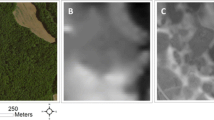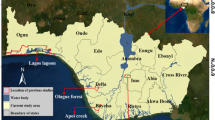Abstract
Small, temporally dynamic, biologically diverse isolated wetlands are among the most imperiled ecosystems, yet their conservation is hindered by lack of protective legislation and mapping. As part of an effort to better understand isolated wetland ecology in an area undergoing dramatic land use change, we mapped isolated wetlands in South Carolina’s Piedmont and Blue Ridge regions using remote sensing and local ecological knowledge (LEK). Remote detection of isolated wetlands was limited by digital resource resolution, topography, and wetland size. LEK was the most useful tool for locating small isolated wetlands. We sampled 10% of the study area using LEK and discovered 44 wetlands with “isolated” characteristics, none of which had been identified by remote sensing. Only 8 of 44 wetlands found through LEK could be identified using remote sensing after their discovery. LEK fills a gap in cryptic ecosystem detection when adequate remotely sensed data are not available. Though effective, using LEK is neither as rapid nor as repeatable as remote sensing. We suggest a two-pronged approach for finding cryptic ecosystems: remote sensing coupled with LEK where data resolution is inadequate. For remote detection of isolated wetlands, we suggest a minimum resolution of 0.33 m for Color Infrared, leaf-off, high-water photography. Despite great advances in remote sensing, data are not uniformly available worldwide and LEK may serve as an effective tool for locating cryptic resources for biodiversity conservation. Mapping cryptic resources will allow for more accurate resource and biodiversity conservation planning under current and future climate scenarios.


Similar content being viewed by others
Abbreviations
- CIR:
-
Color infrared
- DEM:
-
Digital elevation model
- DOQ:
-
Digital orthophoto quadrangles
- DOQQ:
-
Digital orthophoto quarter quadrangles
- GIS:
-
Geographic information system
- GPS:
-
Global positioning system
- HUC:
-
Hydrologic unit code
- LEK:
-
Local ecological knowledge
- LiDAR:
-
Light Detection and Ranging
- NAPP:
-
National Aerial Photography Program
- NWI:
-
National wetlands inventory
- SC DNR:
-
South Carolina Department of Natural Resources
- SSURGO:
-
Soil Survey Geographic
- USGS:
-
United States Geological Survey
References
Anderson MG, Ferree CE (2010) Conserving the stage: climate change and the geophysical underpinnings of species diversity. PLoS One 5:e11554
Attum O, Lee YM, Roe JH, Kingsbury BA (2008) Wetland complexes and upland-wetland linkages: landscape effects on the distribution of rare and common wetland reptiles. J Zool 275:245–251
Baldwin RF, deMaynadier PG (2009) Assessing threats to pool-breeding amphibian habitat in an urbanizing landscape. Biol Conserv 142:1628–1638
Baldwin RF, Calhoun AJK, deMaynadier PG (2006) Conservation planning for amphibian species with complex habitat requirements: a case study using movements and habitat selection of the wood frog Rana sylvatica. J Herpetol 40:443–454
Beier P, Brost B (2010) Use of land facets to plan for climate change: conserving the arenas, not the actors. Conserv Biol 24:701–710
Brinson MM, Malvarez AI (2002) Temperate freshwater wetlands: types, status, and threats. Environ Conserv 29:115–133
Burne MR, Lathrop RG Jr (2008) Remote and field identification of vernal pools. In: Calhoun AJK, deMaynadier PG (eds) Science and conservation of vernal pools in northeastern North America. CRC Press, Boca Raton, pp 55–68
Calhoun AJK, deMaynadier PG (2008) Science and conservation of vernal pools in northeastern North America. CRC Press, Boca Raton
Calhoun AJK, Walls TE, Stockwell SS, McCollough M (2003) Evaluating vernal pools as a basis for conservation strategies: a Maine case study. Wetlands 23:70–81
Campbell CE, Allen J, Lu KS (2008) Modeling growth and predicting future developed land in the upstate of South Carolina. Proceedings of the 2008 South Carolina Water Resources Conference, Clemson University Restoration Institute, Clemson. http://www.clemson.edu/restoration/events/past_events/sc_water_resources/t1_proceedings_presentations/t1_zip/campbellc.pdf. Cited August 2010
Carpenter L, Stone J, Griffin CR (2011) Accuracy of aerial photography for locating seasonal (vernal) pools in Massachusetts. Wetlands 31:573–581
Clark PJ, Reed JM, Chew FS (2007) Effects of urbanization on butterfly species richness, guild structure, and rarity. Urban Ecosyst 10:321–337
Colburn EA (2004) Vernal pools natural history and conservation. McDonald & Woodward Publishing Co., Blacksburg
Colburn EA, Weeks SC, Reed SK (2008) Diversity and ecology of vernal pool invertebrates. In: Calhoun AJK, deMaynadier PG (eds) Science and conservation of vernal pools in northeastern North America. CRC Press, Boca Raton, pp 105–126
Cutko A, Rawinski TJ (2008) Flora of northeastern vernal pools. In: Calhoun AJK, deMaynadier PG (eds) Science and conservation of vernal pools in northeastern North America. CRC Press, Boca Raton, pp 71–104
Frohn RC, Reif M, Lane C, Autrey B (2009) Satellite remote sensing of isolated wetlands using object-oriented classification of Landsat-7 data. Wetlands 29:931–941
Gagne SA, Fahrig L (2007) Effect of landscape context on anuran communities in breeding ponds in the National Capital Region, Canada. Landscape Ecol 22:205–215
Gibbs JP (2000) Wetland loss and biodiversity conservation. Conserv Biol 14:314–317
Girvetz EH, Zganjar C, Raber GT, Maurer EP, Kareiva P, Lawler JJ (2009) Applied climate-change analysis: the climate wizard tool. PLoS One 4:e8320
Groom MJ, Vynne CH (2006) Habitat degradation and loss. In: Groom MJ, Meffe GK, Carroll CR (eds) Principles of conservation biology, 3rd edn. Sinauer Associates Inc., Sunderland, pp 173–212
Groves CR, Jensen DB, Valutis LL, Redford KH, Shaffer ML, Scott JM, Baumgartner JV, Higgins JV, Beck MW, Anderson MG (2002) Planning for biodiversity conservation: putting conservation science into practice. Bioscience 52:499–512
Grumbine RE (1994) What is ecosystem management? Conserv Biol 8(1):27–38
Hepinstall JA, Alberti M, Marzluff JM (2008) Predicting land cover change and avian community responses in rapidly urbanizing environments. Landscape Ecol 23:1257–1276
Herbet ME, McIntyre PB, Doran PJ, Allan JD, Abell R (2010) Terrestrial reserve networks do not adequately represent aquatic ecosystems. Conserv Biol 34:1002–1011
Hogg AR, Holland J (2008) An evaluation of DEMS derived from LiDAR and photogrammetry for wetland mapping. Forest Chron 84:840–849
Hunter ML Jr (2008) Valuing and conserving vernal pools as small-scale ecosystems. In: Calhoun AJK, deMaynadier PG (eds) Science and conservation of vernal pools in northeastern North America. CRC Press, Boca Raton, pp 1–8
Joyal LA, McCollough M, Hunter ML Jr (2001) Landscape ecology approaches to wetland species conservation: a case study of two turtle species in southern Maine. Conserv Biol 15:1755–1762
Julian JT, Young JA, Jones JW, Snyder CD, Wright CW (2009) The use of local indicators of spatial association to improve LiDAR-derived predictions of potential amphibian breeding ponds. J Geogr Syst 11:89–106
Lang MW, McCarty GW (2009) Lidar intensity for improved detection of inundation below the forest canopy. Wetlands 29:116–1178
Leibowitz SG (2003) Isolated wetlands and their functions: an ecological perspective. Wetlands 23:17–31
Leibowitz SG, Brooks RT (2008) Hydrology and landscape connectivity of vernal pools. In: Calhoun AJK, deMaynadier PG (eds) Science and conservation of vernal pools in northeastern North America. CRC Press, Boca Raton, pp 31–53
Lowe WH, Likens GE (2005) Moving headwater streams to the head of the class. Bioscience 55:196–197
Mahaney WS, Klemens MW (2008) Vernal pool conservation policy: the federal state, and local context. In: Calhoun AJK, deMaynadier PG (eds) Science and conservation of vernal pools in northeastern North America. CRC Press, Boca Raton, pp 193–212
Margules CR, Pressey RL (2000) Systematic conservation planning. Nature 405:243–253
Maxa M, Bolstad P (2009) Mapping northern wetlands with high resolution satellite images and LiDAR. Wetlands 29:248–260
Mitchell JC, Paton PWC, Raithel CJ (2008) The importance of vernal pools to reptiles, birds, and mammals. In: Calhoun AJK, deMaynadier PG (eds) Science and conservation of vernal pools in northeastern North America. CRC Press, Boca Raton, pp 169–190
Napton DE, Auch RF, Headley R, Taylor JL (2010) Land changes and their driving forces in the southeastern United States. Reg Environ Change 10:37–53
Oscarson DB, Calhoun AJK (2007) Developing vernal pool conservation plans at the local level using citizen-scientists. Wetlands 27:80–95
Pyke CR (2004) Habitat loss confounds climate change impacts. Front Ecol Environ 2:178–182
Rheinhardt RD, Hollands GG (2008) Classification of vernal pools: geomorphic setting and distribution. In: Calhoun AJK, deMaynadier PG (eds) Science and conservation of vernal pools in northeastern North America. CRC Press, Boca Raton, pp 11–29
Semlitsch RD, Bodie JR (1998) Are small, isolated wetlands expendable? Conserv Biol 12:1129–1133
Semlitsch RD, Skelly DK (2008) Ecology and conservation of pool-breeding amphibians. In: Calhoun AJK, deMaynadier PG (eds) Science and conservation of vernal pools in northeastern North America. CRC Press, Boca Raton, pp 127–147
Tiner RW Jr (1990) Use of high-altitude aerial photography for inventorying forested wetlands in the United States. Forest Ecol Manag 33–34:593–604
Tiner RW Jr (2003) Geographically isolated wetlands of the United States. Wetlands 23:494–516
Trombulak SC (2010) Assessing irreplaceability for systematic conservation planning. In: Trombulak SC, Baldwin RF (eds) Landscape-scale conservation planning. Springer, Dordrecht, pp 303–324
U.S. Fish and Wildlife Service (2002) National wetlands inventory: a strategy for the 21st century. U.S. Fish and Wildlife Service, Washington
Wear DN, Greis JG (2002) Southern forest resource assessment: summary of findings. J Forest 100(7):6–14
Windmiller B, Calhoun AJK (2008) Conserving vernal pool wildlife in urbanizing landscapes. In: Calhoun AJK, deMaynadier PG (eds) Science and conservation of vernal pools in northeastern North America. CRC Press, Boca Raton, pp 233–251
World Database on Protected Areas (2010) World Database on Protected Areas incorporating the UN list of protected areas. http://www.wdpa.org. Cited August 2011
Zedler PH (2003) Vernal pools and the concept of “isolated wetlands”. Wetlands 23:597–607
Acknowledgments
We extend our gratitude to the many individuals from the South Carolina State Parks, Upstate Forever, South Carolina Department of Natural Resources, and U.S. National Forest Service, as well as John Garten, for assistance in locating wetlands. We thank the numerous Clemson undergraduate and graduate students who participated in the field work for this project. Funding for this project was provided by the Environmental Protection Agency Region 4 WPDG. Comments from two anonymous reviewers resulted in a greatly improved manuscript.
Author information
Authors and Affiliations
Corresponding author
Rights and permissions
About this article
Cite this article
Pitt, A.L., Baldwin, R.F., Lipscomb, D.J. et al. The missing wetlands: using local ecological knowledge to find cryptic ecosystems. Biodivers Conserv 21, 51–63 (2012). https://doi.org/10.1007/s10531-011-0160-7
Received:
Accepted:
Published:
Issue Date:
DOI: https://doi.org/10.1007/s10531-011-0160-7




